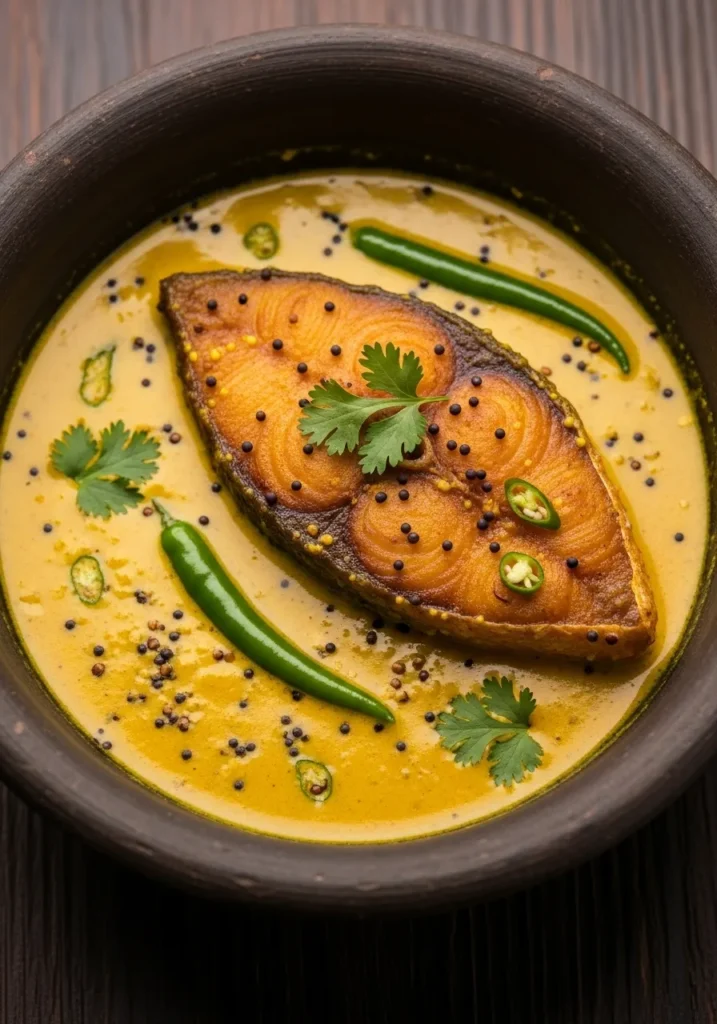So, you’re staring into the fridge, willing something delicious to magically appear. You want a meal that screams “gourmet chef” but whispers “minimal effort.” I feel you. We’ve all been there, my friend. That’s where this glorious, zesty, and downright incredible Fish in Mustard Sauce swoops in to save your Tuesday (or Wednesday, or let’s be real, any day that ends in ‘y’).
Why This Recipe is Awesome
Let’s cut to the chase. This isn’t your grandma’s bland, boiled fish (no offense, Grandma). This is a flavor explosion. It’s restaurant-level impressive without the restaurant-level price tag or the need to put on pants. It’s shockingly easy to make, it’s ready in under 30 minutes, and it features a sauce so good you’ll want to drink it with a straw. I’m not judging if you do. Plus, mustard is basically a superfood for flavor. It does all the heavy lifting while you just stand there looking clever.
Ingredients You’ll Need for Fish In Mustard Sauce
Gather your squad. This is the crew that’s going to make magic happen. Pro tip: read this before you go to the store to avoid a second trip. We’ve all done it.
- White Fish Fillets (about 1 lb): Cod, haddock, tilapia, or any other firm white fish. Thaw it if it’s frozen. Don’t be that person.
- Dijon Mustard (3 tbsp): The star of the show. Don’t skimp. The grainy kind is best for maximum texture and flavor punch.
- Whole Grain Mustard (1 tbsp): For a little extra texture and a mild, nutty vibe. If you don’t have it, just use an extra tbsp of Dijon. No biggie.
- Heavy Cream (1/2 cup): This is what makes the sauce luxuriously rich and silky. Half-and-half can work in a pinch, but your sauce will be thinner. FYI.
- White Wine (1/4 cup): A dry one like Sauvignon Blanc or Pinot Grigio. It adds a lovely acidity. (Substitute: chicken or vegetable broth with a tiny squeeze of lemon juice).
- Shallot (1, finely chopped): It’s like a fancy, milder onion. If you’re in a bind, a quarter of a regular onion will do.
- Garlic (2 cloves, minced): Because is it even a recipe without garlic?
- Fresh Parsley or Dill (a handful, chopped): For that fresh, green pop at the end. Dill is a classic with fish, but parsley works great too.
- Butter (1 tbsp): For sautéing. Because butter makes everything better. It’s a scientific fact.
- Olive Oil (1 tbsp): To prevent the butter from burning. We’re being fancy and smart.
- Salt and Pepper: To taste. Obviously.
Step-by-Step Instructions
- Pat Your Fish Dry. This is the most important step you’ll be tempted to skip. Seriously, pat those fillets completely dry with a paper towel. This is the secret to getting a nice sear and not ending up with a steamed, mushy mess. Season both sides generously with salt and pepper.
- Sauté the Aromatics. Heat the olive oil and butter in a large skillet over medium heat. Once the butter is foaming, toss in the chopped shallot. Cook for 2-3 minutes until it’s soft and translucent. Add the garlic and cook for just another 30 seconds until it’s fragrant. Don’t let it burn!
- Cook the Fish. Push the shallots and garlic to the side of the pan. Increase the heat to medium-high. Place your dry, seasoned fish fillets in the pan. Cook for 3-4 minutes per side (depending on thickness) until beautifully golden and cooked through. Remove the fish from the pan and set it on a plate to rest.
- Create the Magical Sauce. Lower the heat to medium. Pour the white wine into the pan to deglaze it, scraping up all those delicious browned bits with a wooden spoon. Let it simmer for a minute to reduce slightly. Whisk in both mustards and the heavy cream until everything is beautifully combined.
- Simmer and Serve. Let the sauce simmer gently for 2-3 minutes until it thickens slightly. Taste it! This is your moment. Add more salt or pepper if it needs it. Slide the fish fillets back into the pan, spooning that glorious sauce all over them to warm through. Sprinkle with your fresh herbs.
Common Mistakes to Avoid
- Skipping the Pat-Dry: I said it once, I’ll say it again. Wet fish = steamed fish. We’re not steaming. We’re searing. Get those paper towels ready.
- Crowding the Pan: If your skillet is too small for all the fillets, cook them in two batches. Overcrowding makes the pan temperature drop, and you’ll end up boiling the fish instead of searing it. Patience, young grasshopper.
- Boiling the Sauce: Once you add the cream, keep the heat at a gentle simmer. A rolling boil might cause the sauce to break or curdle. Low and slow is the way to go for a smooth, creamy sauce.
Alternatives & Substitutions
Dietary needs or missing an ingredient? I got you.
- Dairy-Free? Swap the heavy cream for full-fat canned coconut milk. It adds a subtle sweetness that works surprisingly well with the mustard.
- No Wine? No worries! Use an equal amount of broth (chicken or veg) and add a good squeeze of fresh lemon juice at the end to mimic the acidity.
- Not a Mustard Fanatic? Start with half the amount of mustard, taste, and add more. You can always add, but you can’t take away!
- Want More Veg? Throw a handful of spinach into the sauce right before you add the fish back in, or serve it over a bed of sautéed zucchini noodles.
FAQs about Fish In Mustard Sauce
What’s the best fish to use for this?
You want a firm, mild white fish that won’t fall apart on you. Cod and haddock are my top picks. Tilapia works in a pinch, but it can be a bit more fragile. Avoid super flaky fish like sole for this particular recipe.
Can I use dried herbs instead of fresh?
You can, but IMO, fresh herbs really make a difference here, especially for the garnish. The sauce is rich and needs that fresh, bright note at the end. If you must use dried, use about one-third of the amount and add it when you’re making the sauce so it has time to rehydrate.
How do I know when the fish is done?
The best way is to gently poke it with a fork or your finger. If it flakes easily and is opaque all the way through, it’s done. You can also use a thermometer—fish is perfectly cooked at 145°F (63°C).
My sauce is too thin! How do I thicken it?
Let it simmer a bit longer—it will naturally reduce and thicken. If you’re really in a rush, you can make a quick slurry with a teaspoon of cornstarch and a tablespoon of cold water, whisk it in, and let it simmer for a minute.
Can I make this ahead of time?
The sauce can be made a day ahead and stored in the fridge. Gently reheat it in a pan before adding freshly cooked fish. I wouldn’t cook the fish ahead of time, as it’s best served immediately.
Related Recipes
Final Thoughts about Fish In Mustard Sauce
And there you have it. A stupidly simple, ridiculously delicious meal that will make you feel like a total rockstar. You took a few simple ingredients and turned them into pure gold. Now go forth and conquer that kitchen. Plate it up, maybe with some crusty bread to mop up every last drop of that sauce, and take a bow. You’ve earned it
Printable Recipe Card
Want just the essential recipe details without scrolling through the article? Get our printable recipe card with just the ingredients and instructions.



